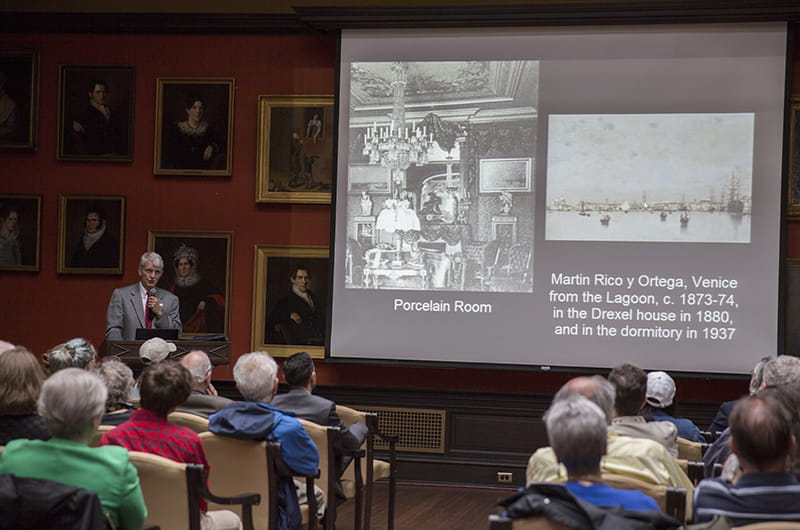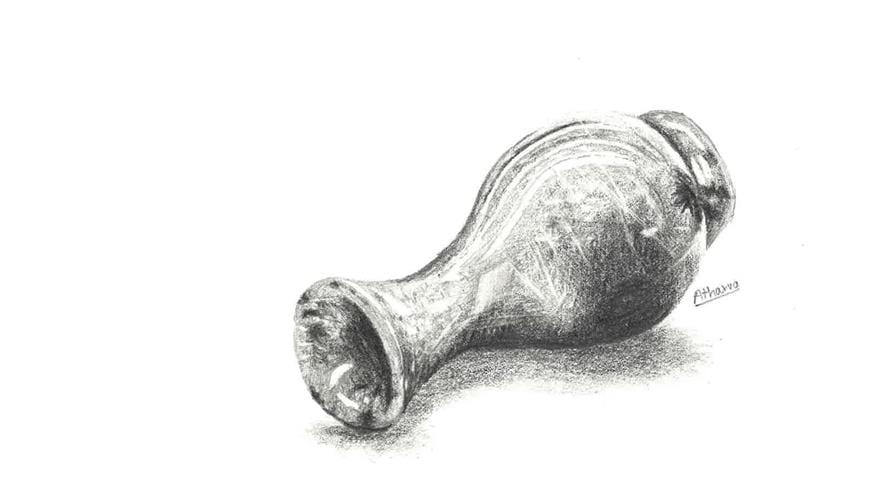Founder Anthony J. Drexel's Art on Campus — and at Home

This article is part of the DrexelNow “Faces of Drexel” series honoring Drexel’s history as part of the University-wide celebration of the 125th anniversary of Drexel’s founding in 1891.
It’s easy to guess that The Drexel Collection and the A.J. Drexel Picture Gallery have something to do with — who else? — Drexel University founder Anthony J. Drexel.
Actually seeing the connection, however, is a different story.
The philanthropist and financier bequeathed much of his personal art collection to the Drexel Museum, now known as The Drexel Collection, when he died in 1893. Those artworks, big and small, painting and sculpture (and then some), are still part of the University today — and you’ve most likely walked by them before.
When Drexel was alive, those paintings and sculptures were displayed in his house, a sprawling Italian villa in the then-countryside of West Philadelphia. He had purchased the land between 38th and 39th streets and Walnut Street in the 1850s and moved there from his former homestead on the south side of ritzy Rittenhouse Square. He then went on to build five mansions for his children within a block of his own home, which caused people to call the area “the Drexel family compound” and “the Drexel block.”

“His own palace had forty-one rooms and was the show place of the colony, which also included the imposing residences of three of his sons and a daughter. With these clustered together, it was possible to go from one to the other without using the public sidewalks,” wrote Cordelia Drexel Biddle, his great-granddaughter, in “My Philadelphia Father,” which was later turned into a Disney movie about Drexel’s grandson.
Drexel’s home was demolished by the University of Pennsylvania in the 20th century to make way for dormitories, but the luxuriousness of the Drexel estate lives on through photographs of its interior taken in 1893 (and now found in University Archives).
“This is fabulous visual documentation, as it shows us the artworks in their original late Victorian setting,” said Charles Morscheck, PhD, an art history professor in the Westphal College of Media Arts & Design, at a lecture he recently gave titled “The House on Walnut and the Museum on Chestnut: Observations on the Early History of The Drexel Collection.”
Morscheck’s connection to The Drexel Collection dates back to the 1990s, when he stepped in to help keep it alive after its staff was let go. During that time, Morscheck also taught service learning classes in which students helped display its art in cases in Main Building. He first started informally researching Drexel’s art and other paintings in The Drexel Collection in those pre-Internet days (though it has gotten easier to look up information).
Morscheck analyzed those pictures to give context to Drexel, not as a founder or financier or philanthropist but as an art collector. Drexel’s father, Francis Martin Drexel, had been a painter but gave it up to become a successful banker. The elder Drexel “rigorously but lovingly supervised his children’s training in music, languages and art,” with his son becoming “well informed about art and music,” according to Dan Rottenberg, author of “The Man Who Made Wall Street: Anthony J. Drexel and the Rise of Modern Finance.”
As a result, Drexel loved to play the piano (his 1876 rosewood Steinway grand piano, part of The Drexel Collection, is in the A.J. Picture Gallery) and frequently attended musical concerts. His reputation as an art collector was cemented when his private art collection was reviewed alongside those of his younger brother Joseph as well as the powerful Morgan, Vanderbilt and Rockefeller families in the seminal 1880 three-volume series “Art Treasures in America,” written by noted art critic and historian Earl Shinn (using the pseudonym Edward Strahan).

“A considerable proportion of decorative pictures of the modern Spanish school characterizes the collection in Mr. A.J. Drexel’s West Philadelphia home — a delicious rus in urbe [a Latin phrase for “country in the city”], whose groves and parks are spread in the midst of city squares,” Shinn wrote, highlighting Drexel’s works belonging to then-modern Spanish painters Federico de Madrazo, Martín Rico and Luis Jiménez y Aranda.
“Their united productions tend to give a tone of enchantment to the premises where they are preserved,” Shinn wrote of the art in Drexel’s house. “None of the asceticism of a timid taste, reducing the color melodies of the world to still uniformity, or extolling the beauty of faded tints, can remain in a home thus brightened with daring coruscations, and sparkling with the gaieties of the solar spectrum from every wall.”
Based on the paintings described in “Art Treasures in America,” as well as the photographs of Drexel’s home and early 20th century University photographs and catalogs, Morscheck says that Drexel’s taste in wall art favored 19th century European landscape and seascape paintings and pictures of soldiers and members of various social classes. But Drexel mostly stopped collecting art by the 1880s — which is why Morscheck thinks that he simply found “opportunities to buy these paintings and needed something to fill up the walls of all those rooms in his mansion.” When the walls were completely adorned, Drexel stopped purchasing art.
When Drexel died, most of his art went to the then-Drexel Institute of Art, Science and Industry, which had opened just 18 months prior. An even larger bequest of paintings from Drexel's brother-in-law, John D. Lankenau, followed in 1903. Most of that art remains a part of the University today — except for a substantial amount sold in a 1944 Parke-Bernet auction to raise funds and support the war effort (Drexel also sold more than 250 autographed manuscripts and letters from notable literary and historical figures). Many of the paintings sold had been sitting in storage, rather than displayed around campus, including artworks of small size and/or subject matter deemed not appropriate for Drexel students, such as sensuous depictions of women and religious pictures.
What remains of Drexel’s art remains in The Drexel Collection and can be found around campus, mostly in Main Building. You can see for yourself in the images below, which show the art displayed in Drexel’s house in 1893 and where they are now at the University in 2017.
In This Article
Drexel News is produced by
University Marketing and Communications.

